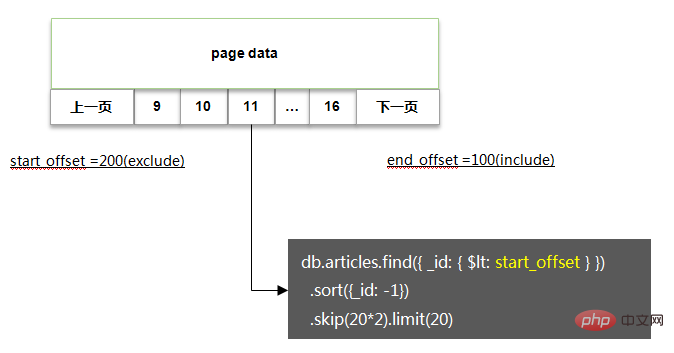 Backend Development
Backend Development
 PHP Tutorial
PHP Tutorial
 How to be compatible with MySQL + ES + MongoDB to achieve deep paging of hundreds of millions of data?
How to be compatible with MySQL + ES + MongoDB to achieve deep paging of hundreds of millions of data?
How to be compatible with MySQL + ES + MongoDB to achieve deep paging of hundreds of millions of data?

##Interview Questions & Real Experience
Interview question: How to achieve deep paging when the amount of data is large?You may encounter the above questions during interviews or when preparing for interviews. Most of the answers are basically to divide databases and tables to build indexes. This is a very standard correct answer, but Reality is always very hard, so the interviewer will usually ask you, now that the construction period is insufficient and the personnel are insufficient, how can we achieve deep paging? At this time, students who have no practical experience are basically numb. So, please listen to me.
Painful Lessons
First of all, it must be clear: depth paging can be done, but depth is random Page jumps absolutely need to be banned. Previous picture:
Why random depth page jumps cannot be allowed
Let’s briefly talk about why random depth page jumps cannot be allowed from a technical point of view, or that Why is deep paging not recommended?MySQL
The basic principle of paging:SELECT * FROM test ORDER BY id DESC LIMIT 10000, 20;
MongoDB
The basic principle of paging:db.t_data.find().limit(5).skip(5);
ElasticSearch
From a business perspective, ElasticSearch is not a typical database. It is a search engine. If the desired data is not found under the filter conditions , we will not find the data we want if we continue deep paging. To take a step back, if we use ES as a database for query, we will definitely encounter the limit of max_result_window when paging. Did you see it? Officials tell you the maximum The offset limit is ten thousand. Query process:- If you query page 501, with 10 items per page, the client sends a request to a certain node
- This node broadcasts data to each shard, and each shard queries the first 5010 pieces of data.
- The query results are returned to the node, and then the data is integrated and the first 5010 pieces of data are retrieved.
- Return to the client
Align with the product again
As the saying goes, problems that cannot be solved by technology should be solved by business! During my internship, I believed in the evil of the product, and it was necessary to implement deep paging and page jumps. Now we must correct the chaos, and the following changes must be made in the business: Add default filtering conditions as much as possible, such as : Time period, the purpose is to reduce the amount of data displayedModify the display method of page jumps, change it to scrolling display, or jump pages in a small rangeScrolling display reference picture:

##General solutionThe quick solution in a short period of time mainly includes the following points:
- Required: For sorting fields and filter conditions, the index must be set
- Core: Use known data of small range page numbers, or known data of rolling loading, to reduce the offset
- Extra: If you encounter a situation that is difficult to handle, You can also obtain excess data and intercept it to a certain extent, and the performance impact will not be significant
Original paging SQL:
# 第一页 SELECT * FROM `year_score` where `year` = 2017 ORDER BY id limit 0, 20; # 第N页 SELECT * FROM `year_score` where `year` = 2017 ORDER BY id limit (N - 1) * 20, 20;
Through context, rewritten as:
# XXXX 代表已知的数据 SELECT * FROM `year_score` where `year` = 2017 and id > XXXX ORDER BY id limit 20;
在 没内鬼,来点干货!SQL优化和诊断 一文中提到过,LIMIT会在满足条件下停止查询,因此该方案的扫描总量会急剧减少,效率提升Max!
ES
方案和MySQL相同,此时我们就可以随用所欲的使用 FROM-TO Api,而且不用考虑最大限制的问题。
MongoDB
方案基本类似,基本代码如下:

相关性能测试:

如果非要深度随机跳页
如果你没有杠过产品经理,又该怎么办呢,没关系,还有一丝丝的机会。
在 SQL优化 一文中还提到过MySQL深度分页的处理技巧,代码如下:
# 反例(耗时129.570s) select * from task_result LIMIT 20000000, 10; # 正例(耗时5.114s) SELECT a.* FROM task_result a, (select id from task_result LIMIT 20000000, 10) b where a.id = b.id; # 说明 # task_result表为生产环境的一个表,总数据量为3400万,id为主键,偏移量达到2000万
该方案的核心逻辑即基于聚簇索引,在不通过回表的情况下,快速拿到指定偏移量数据的主键ID,然后利用聚簇索引进行回表查询,此时总量仅为10条,效率很高。
因此我们在处理MySQL,ES,MongoDB时,也可以采用一样的办法:
限制获取的字段,只通过筛选条件,深度分页获取主键ID
通过主键ID定向查询需要的数据
瑕疵:当偏移量非常大时,耗时较长,如文中的 5s
推荐教程:《MySQL教程》
文章来源:https://juejin.im/post/5f0de4d06fb9a07e8a19a641
The above is the detailed content of How to be compatible with MySQL + ES + MongoDB to achieve deep paging of hundreds of millions of data?. For more information, please follow other related articles on the PHP Chinese website!

Hot AI Tools

Undresser.AI Undress
AI-powered app for creating realistic nude photos

AI Clothes Remover
Online AI tool for removing clothes from photos.

Undress AI Tool
Undress images for free

Clothoff.io
AI clothes remover

AI Hentai Generator
Generate AI Hentai for free.

Hot Article

Hot Tools

Notepad++7.3.1
Easy-to-use and free code editor

SublimeText3 Chinese version
Chinese version, very easy to use

Zend Studio 13.0.1
Powerful PHP integrated development environment

Dreamweaver CS6
Visual web development tools

SublimeText3 Mac version
God-level code editing software (SublimeText3)

Hot Topics
 PHP's big data structure processing skills
May 08, 2024 am 10:24 AM
PHP's big data structure processing skills
May 08, 2024 am 10:24 AM
Big data structure processing skills: Chunking: Break down the data set and process it in chunks to reduce memory consumption. Generator: Generate data items one by one without loading the entire data set, suitable for unlimited data sets. Streaming: Read files or query results line by line, suitable for large files or remote data. External storage: For very large data sets, store the data in a database or NoSQL.
 How to use MySQL backup and restore in PHP?
Jun 03, 2024 pm 12:19 PM
How to use MySQL backup and restore in PHP?
Jun 03, 2024 pm 12:19 PM
Backing up and restoring a MySQL database in PHP can be achieved by following these steps: Back up the database: Use the mysqldump command to dump the database into a SQL file. Restore database: Use the mysql command to restore the database from SQL files.
 How to optimize MySQL query performance in PHP?
Jun 03, 2024 pm 08:11 PM
How to optimize MySQL query performance in PHP?
Jun 03, 2024 pm 08:11 PM
MySQL query performance can be optimized by building indexes that reduce lookup time from linear complexity to logarithmic complexity. Use PreparedStatements to prevent SQL injection and improve query performance. Limit query results and reduce the amount of data processed by the server. Optimize join queries, including using appropriate join types, creating indexes, and considering using subqueries. Analyze queries to identify bottlenecks; use caching to reduce database load; optimize PHP code to minimize overhead.
 How to insert data into a MySQL table using PHP?
Jun 02, 2024 pm 02:26 PM
How to insert data into a MySQL table using PHP?
Jun 02, 2024 pm 02:26 PM
How to insert data into MySQL table? Connect to the database: Use mysqli to establish a connection to the database. Prepare the SQL query: Write an INSERT statement to specify the columns and values to be inserted. Execute query: Use the query() method to execute the insertion query. If successful, a confirmation message will be output.
 How to create a MySQL table using PHP?
Jun 04, 2024 pm 01:57 PM
How to create a MySQL table using PHP?
Jun 04, 2024 pm 01:57 PM
Creating a MySQL table using PHP requires the following steps: Connect to the database. Create the database if it does not exist. Select a database. Create table. Execute the query. Close the connection.
 How to use MySQL stored procedures in PHP?
Jun 02, 2024 pm 02:13 PM
How to use MySQL stored procedures in PHP?
Jun 02, 2024 pm 02:13 PM
To use MySQL stored procedures in PHP: Use PDO or the MySQLi extension to connect to a MySQL database. Prepare the statement to call the stored procedure. Execute the stored procedure. Process the result set (if the stored procedure returns results). Close the database connection.
 How to fix mysql_native_password not loaded errors on MySQL 8.4
Dec 09, 2024 am 11:42 AM
How to fix mysql_native_password not loaded errors on MySQL 8.4
Dec 09, 2024 am 11:42 AM
One of the major changes introduced in MySQL 8.4 (the latest LTS release as of 2024) is that the "MySQL Native Password" plugin is no longer enabled by default. Further, MySQL 9.0 removes this plugin completely. This change affects PHP and other app
 The difference between oracle database and mysql
May 10, 2024 am 01:54 AM
The difference between oracle database and mysql
May 10, 2024 am 01:54 AM
Oracle database and MySQL are both databases based on the relational model, but Oracle is superior in terms of compatibility, scalability, data types and security; while MySQL focuses on speed and flexibility and is more suitable for small to medium-sized data sets. . ① Oracle provides a wide range of data types, ② provides advanced security features, ③ is suitable for enterprise-level applications; ① MySQL supports NoSQL data types, ② has fewer security measures, and ③ is suitable for small to medium-sized applications.





